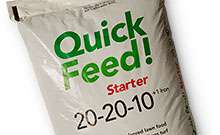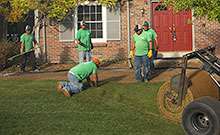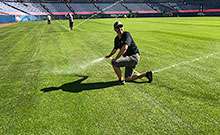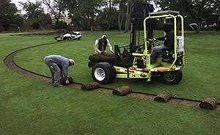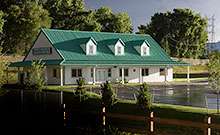Debunking Myths Around Artificial Turf

One of the most controversial topics in the landscaping community is Artificial Turf. Is artificial landscaping better than natural grass? How about the health benefits of a natural vs artificial lawn? Is one better for the environment than the other? We’re here to debunk some of the myths around artificial sod.
Myth 1: Artificial turf uses less water
While this is true, it’s not necessarily the whole story. Artificial turf temperatures can soar, especially in summer. This requires water to cool it down if you want to be able to enjoy your lawn, especially in western climates where installing an artificial lawn might seem like a smart idea to save water. According to Turfgrass Producers International, artificial lawns have been documented to be up to 86.5*F degrees hotter than natural turf under identical conditions. On an average summer 90*F degree day, the surface of artificial turf will be 165*F degrees — that’s hot! Human skin begins to burn at 110*F for long exposures and as little as a few seconds at 165*F. This means frequent watering to cool the surface temperature down for your children or pets to enjoy on a summer day. Water is the only way to cool excessively hot artificial turf.
It can also contribute to the heat island effect. The heat island effect describes built up urban areas that are hotter than nearby rural areas. Which leads to increased energy consumption, elevated emissions of greenhouse gasses, compromised human health and comfort, and can lead to impaired water quality. Artificial turf elevates the temperature of the ground, which in turn elevates the overall temperature of the earth unless cooled by excessive and unnecessary watering.
Myth 2: Artificial turf is made from recycled materials
Many types of artificial lawns are made from plastics, mostly polyethylene and polypropylene — not actually recycled plastics. Plastic grass is a petroleum based product that emits greenhouse gases while it’s being produced. There’s just no getting around that. In addition, most artificial lawns last for about 8-10 years and after that can not be recycled. That ultimately means every 8-10 years the whole lawn has to be thrown away. And here’s the kicker — dumps won’t take them, they’re considered hazardous waste. They also contribute to the microplastics problem. Microplastics are found in our food, water, even in the soil, are consumed by animals — especially sea animals, and are extremely harmful and toxic. As artificial turf is made from plastic, it’s impossible for it to not contribute to the microplastic epidemic we are currently facing.
Myth 3: Artificial turf cuts down greenhouse emissions
Another common setback people point to with traditional lawns is the maintenance they require and the fact that lawnmowers and fertilizer aren’t exactly good for the environment. As we’ve already discussed, plastic turf is still made of plastic and does release greenhouse gases while it’s being made. Another common practice with artificial turf is to remove the soil below and replace it with rock which releases even more CO2 emissions! Overall, natural lawns contribute to filtering CO2 from the air while plastic sod actually does the opposite. It’s easy to make a natural lawn more environmentally friendly by making the switch to organic fertilizer and electric mowers, but artificial turf will continue to contribute to creating more unnecessary plastics, and therefore contribute to creating more greenhouse emissions.
Myth 4: Artificial turf helps bolster wildlife because it’s better for the environment
Artificial Turf provides absolutely no nutrients to any wildlife and actually harms very important members of our ecosystem — worms and bees. It seals the ground below keeping essential nutrients from finding their way back into the soil. Because of this, it starves earthworms from what they need to survive. This makes it impossible for them to continue to bolster the soil quality helping plants grow. We also know how important and crucial bees are to the environment, nothing grows without them! With the plummeting number of insects on earth it’s important to support these species as much as we can.
Myth 5: Artificial turf is cleaner than natural grass because it doesn’t require fertilizer.
Another area artificial turf falls short is in the health department. While natural grass can be criticized for its use of fertilizer and pesticides, there are tons of natural and effective alternatives out there. Organic fertilizer is a great option that still supports your lawn without all the harmful chemicals. Artificial turf is often filled with recycled tire crumbs which have high pollutant content — including lead. The CDC and EPA are currently studying the carcinogenic effects that being exposed to artificial fields may have on public health.
Myth 6: Artificial turf is more cost effective
Champions of artificial turf will say that an artificial lawn is more cost effective because they don’t require water or maintenance throughout the year. We already debunked the water myth earlier, and actually, artificial sod does still require maintenance. Especially in a professional setting. Artificial fields still require a field manager to keep up with the quality. For homeowners, this isn’t as much of a concern, but the initial price of installation is.
For a 500sq foot lawn, the average price of installing artificial sod is around $6,250. That’s nearly 5 times what it would cost to have a professional crew like our sod installation crew come to your house, fully soil prep and grade your lawn and then lay the sod for you. Installed artificial sod is typically between $5-$20 per square foot, on average about $12.50, versus natural sod which, with full soil prep grade and installation, costs about $2.70 or bought on it’s own and easily installed as a weekend DIY, about $0.71 per square foot.
Myth 7: Playing on artificial sod is the same risk as playing on natural sod
Given the rise of popularity of artificial turf for professional sports fields, many studies have come out in recent years tracking injury rates. The NFL has reported non-contact injuries are 27% higher on synthetic turf. Studies have also shown that there is a 50% higher chance of knee or ankle injury on artificial turf as opposed to natural grass. Artificial turf can also cause more turf burns, higher risk of concussion, and higher risk of ACL tears. Players generally prefer playing on natural grass, and Dick Allen, 1972 American League MVP, even said “If a cow can’t eat it, I don’t want to play on it”! How does this translate to the homeowner? Your kids and pets will use your yard to play. When doing so, they run a significantly higher risk of injury when it’s comprised of artificial turf. When it comes down to it, choosing a natural lawn will literally cut the risk of injury to your kids by half.
In Conclusion
While artificial turf certainly has some benefits, its overall impact on the environment is ultimately negative. Natural lawns are, in the grand scheme of things, the best and most environmentally friendly option out there. They are also more cost effective and significantly safer. For more information on the environmental benefits of natural lawns, see our previous blog “5 Reasons Lawns are Beneficial for the Environment”.






